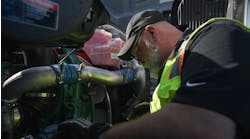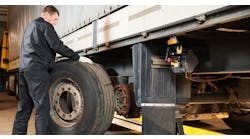Vehicle Maintenance Reporting Standards, known as VMRS, is an alphanumeric coding system that allows individuals and organizations the ability to organize and categorize information into a standardized format.
Licensed by the American Trucking Associations, VMRS was developed in 1969, long before the personal computer was a mainstay in the shop.
“It was developed by maintenance people for maintenance people,” says Jack Poster, VMRS Service Manager at the Technology & Maintenance Council (TMC). “These were people that really knew trucks and equipment, and they came up with this. They were really forward-thinking. It just meshed right into the computer world, it was a perfect fit.”
Anyone and everyone in the commercial vehicle realm may be using VMRS in some form or another, including fleets, vehicle manufacturers, suppliers and maintenance software providers.
“VMRS is unique because it is applied to so many different areas of maintenance and transportation,” Poster says. “A fleet is going to use it to run their maintenance shop. The OEMs don’t have a maintenance shop. They will use it for gathering information about warranty.”
How it’s used by fleets
Poster says VMRS is used as a communication link for everyone in the shop.
“It links anybody in the shop – the maintenance personnel – it links them to their computer, and most important, it brings management into the whole system,” he says.
If you already use a computerized maintenance management software (CMMS) platform in the shop, it likely utilizes VMRS. Many software companies license this coding and integrate it into their own software.
In a fleet setting, Poster says VMRS is often used as a communications link for generating reports.
“It’s part of the repair order. The shop manager or technician – whoever is completing the work order –VMRS will be included in a dropdown,” Poster explains. “There are codes for ‘Reason for repair’ – why did that piece of equipment come into the shop. ‘Failure codes’ – why did that part fail. Instead of a technician writing out three paragraphs, he can just point and click.
“And that’s where the efficiencies come in. You still might have to write some notes, but on everyday repairs or even more involved repairs, it saves time. It saves typing and misspelling.”
In addition to work orders, VMRS can be found in the parts room. Poster says many fleets will organize their parts room by VMRS component codes. The coding convention can also aid in inventory control, by standardizing the inventory control process.
If you’re looking to (adopt/implement) maintenance software, Poster encourages fleets to confirm software companies “have VMRS in the system, and they are updating their codes regularly.”
How information is organized
The breadth of coverage for the different areas of fleet maintenance can be staggering.
At the highest level, VMRS is organized by primary categories known as code keys. There are now 65 active code keys, to cover all aspects of the industry. The most common code keys used by fleets are component code keys (code 33) - which organize parts - and manufacturer supplier brand code keys (code 34) - to track product brands. Additional code key examples include assets, labor, reason for repair, failure codes, etc.
A component code key is a standardized method for organizing vehicle parts.
“The component code is not a parts number replacement, it augments it,” Poster adds.
The component code key consists of more than 32,000 codes to categorize different vehicle systems, assembly and exact component. Each component code key is made up of nine digits – three sets of three digits each.
“There are codes that cover the brake system, engine, transmission parts, to expendable items like work boots and safety glasses,” Poster says. “The fleet can use that number to store their purchases on a repair order, and keep track of what they’re buying. They can also use that to compare reliability and durability between manufacturers.”
For example, 013 designates any part of the braking vehicle system. The second set of digits refers to different aspects of the braking system assembly – 001 for front brakes, 002 for rear brakes, etc.
The last three digits of the nine-digit code refer to the exact component. For instance, 023 within the braking vehicle system will always be a front brake drum. Combined, the component code for a front brake drum would be 013 001 023.
The overall benefit
“With VMRS, it’s a single, concise method for managing fleets, their assets, their maintenance and their costs,” Poster says. “It allows you to simplify, clarify and unify maintenance.”
Poster provides the analogy of a symphony orchestra to describe how the standards work together. Each musician may speak a different language – or work in a different area of the industry - but the musical notes on the sheet music provide a standard way to play together.
“The notes are universal,” Poster says. “If you can read music, that’s it.”



